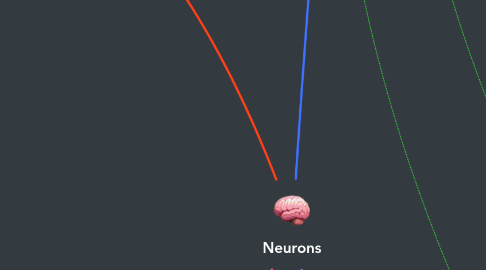
1. What are Neurons?
1.1. Cells of the central nervous system
1.2. Information messengers
1.2.1. By the electrical impulses and chemical signals to transmit information between different areas of the brain, and between the brain and the rest of the nervous system
1.3. Neuron
2. Neurons: Communication (Sending Information)
2.1. Sequence: Action Potential
2.1.1. Feeling a Sharp Object
2.1.1.1. A. The tack produces mechanical pressure on the bottom of your foot.
2.1.1.2. B. Your skin has sensors that pick up the mechanical pressure and transform it into electrical signals
2.1.1.3. C. The sensors' electrical signals are sent by the neuron's axon to various areas in the spinal cord and brain.
2.1.1.4. D. Finally, your brain interprets these electrical signals as "pain".
2.1.2. Axon Membrane: Chemical Gates
2.1.2.1. Has chemical gates that can open to allow electrically charged particles to enter and can close to keep out electrically charged particles.
2.1.3. Ions: Charged Particles
2.1.3.1. Ions are chemical particles that have electrical charges
2.1.3.2. Has two rules: (1) Opposite charges attract, and (2) Like charges repel.
2.1.4. Resting State: Charged Battery
2.1.4.1. It means that the axon has a charge or potential; it resembles a battery.
2.1.4.2. The charge or potential results from axon membrane separating positive ions on the outside from negative ions on the inside.
2.1.4.3. Sodium Pump
2.1.4.3.1. A transport process that picks up any sodium ions that enter the axon's chemical gates and returns them back outside.
2.1.4.3.2. It is responsible for keeping the axon charged by returning and keeping sodium ions outside the axon membrane.
2.1.5. Action Potential: Sending Information
2.1.5.1. A tiny electric current that is generated when the positive sodium ions rush inside the axon.
2.1.5.2. The enormous increase of sodium ions inside the axon causes the inside of the axon to reverse the charge. The inside becomes positive, while the outside becomes negative.
2.2. Sequence: Nerve Impulse
2.2.1. Nerves Impulse: Sending Information
2.2.1.1. Nerve impulse refers to the series of separate action potential that take place segment by segment as they move down the length of an axon.
2.2.2. All-or-None Law
2.2.2.1. A nerve impulse travel down the axon's entire length.
3. Transmitters
3.1. Neurotransmitter
3.1.1. About a dozen different chemicals that are made by neurons
3.1.2. Used for communication between neurons during the performance of mental or physical activities
3.1.3. Norepinephrine
3.1.3.1. Acts as both hormone and neurotransmitter
3.1.3.2. helps speed reaction time
3.1.3.3. increases alertness and arousal
3.1.3.4. works with domaine to help focus
3.1.3.5. works with serotonin to affect mood
3.1.4. Dopamine
3.1.4.1. inhibitory
3.1.4.2. affects mood and complex movements
3.1.4.3. shortage results in muscle rigidity
3.1.5. Serotonin
3.1.5.1. improves mood
3.1.5.2. constricts blood vessels, brings on sleep, temperature regulation
3.1.6. GABA
3.1.6.1. important for visual system
3.1.6.2. Neurons excited by a neurotransmitter
3.1.6.3. helps control muscle activity
3.2. Alcohol
3.2.1. Psychoactive drug that is classified as a depressant
3.2.2. Imitates a naturally occuring neurotransmitter, GABA
3.3. New Transmitters
3.3.1. Endorphins
3.3.1.1. Which secreted to decrease pain during great bodily stress such as accident
3.3.2. Anandamide
3.3.2.1. Surprising Neurotransmitter
3.3.2.2. Help regulate emotions, which would help them cope with anxiety and stress
3.3.3. Nitric Oxide
3.3.3.1. Regulate aggressive and impulsive behaviors
3.3.4. Orexin (Hypocretin)
3.3.4.1. Regulating sleep and wakefulness
3.3.4.1.1. Low levels of this neurotransmitter can cause narcolepsy (sleep disorder)
3.3.4.2. A neurotransmitter involved in the brain's pleasure and reward system
3.4. Excitatory Transmitters
3.4.1. Causes to release strong emotions which open the chemical locks and cause the heart to beat faster
3.5. Inhibitory Transmitters
3.5.1. Occurs when you calm down which it block the chemical locks and decrease its heart rate
4. Structure and functions
4.1. Dendrite
4.1.1. Branchlike extensions that arise from the cell body
4.1.2. They receives signals from other neurons, muscles, or sense organs and pass these signals to the cell body
4.2. Cell body
4.2.1. Contains nucleus
4.2.1.1. Nucleus
4.2.1.1.1. Contains biological instructions, required to synthesize proteins in the neuron.
4.2.2. A relatively large, egg-shaped structure
4.2.3. Provides fuel, manufactures, chemicals, and maintain the entire neuron in working order
4.3. Axon
4.3.1. A single threadlike structure that extends from, and carries signals away from the cell body to neighboring neurons, organs, or muscles.
4.3.2. Conducts electrical signals to a neighboring organ (heart), a muscle, or another neuron.
4.4. Synapse
4.4.1. Site where a neuron communicates
4.4.2. Synaptic terminal
4.4.2.1. Swelling at the end of an axon of the sending neuron.
4.4.2.2. Most of them contain a neurotransmitter that is released in response to an action.
4.4.3. Dendrite or cell body of a receiving neuron.
4.4.4. Infinitely small space (20-30 billions of a meter) that exist between an end bulb and its adjacent body organ (heart), muscles (head), or cell body.
4.5. Myelin sheath
4.5.1. Separate tubelike segments composed of fatty material that wraps around and insulates axon.
4.5.2. Prevents interference from electrical signals generated in adjacent axons.
4.6. Terminal bulbs
4.6.1. Tiny bubbles that are located at the extreme ends of axon's branches.
4.6.2. Stores chemicals called neurotransmitters
